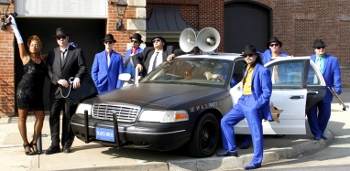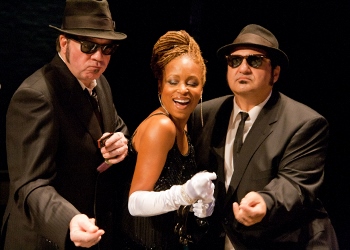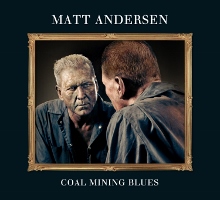We’ve had the pleasure of reviewing some pretty terrific albums in recent weeks, including new releases from Mud Morganfield, Curtis Salgado, the Phantom Blues Band, Pinetop Perkins, Janiva Magness, and Lurrie Bell, among others. But those aren’t the only ones worth adding to your blues music shopping list. Here are a few other recent offerings you’ll also want to make your own.
Volker Strifler – Let the Music Rise (Vizztone)
 Though not exactly a household name (yet), Volker Strifler should be. As a longtime associate of the famous Ford brothers (Robben, Patrick and Mark), Strifler has of course proven his mettle as a guitarist and singer a long time ago, but here delivers the complete package in the form of superb lyrics and vocals, some diverse sounds – including horns, mandolin, pots and pans, and doors – and skill as a producer, in addition to his accomplished fretwork. Indeed, this may be the breakthrough album of the year.
Though not exactly a household name (yet), Volker Strifler should be. As a longtime associate of the famous Ford brothers (Robben, Patrick and Mark), Strifler has of course proven his mettle as a guitarist and singer a long time ago, but here delivers the complete package in the form of superb lyrics and vocals, some diverse sounds – including horns, mandolin, pots and pans, and doors – and skill as a producer, in addition to his accomplished fretwork. Indeed, this may be the breakthrough album of the year.
Those requiring any convincing will find all they need in the funky Allman Brothers-like opener, Sleepy John Estes’ “The Girl I Love She Got Long Curly Hair” (here titled “Going to Brownsville”), that includes some splendid horns and keyboard, and then quite willingly stick around for tracks like the breezy “Redemption” with its Island strains and all the gusto of a Barenaked Ladies tune, and the slow, New Orleans style blues of “It’s Getting Late.”
There’s also a creeping, Beatles-esque take on Fleetwood Mac’s “Jigsaw Puzzle Blues” (with tuba), one of two instrumentals, the other being the whirling country tones and sound effects of the closing “Hoogie Boogie.” The gritty “Wait a Minute” and driving, Allman-sounding title track are nothing short of instant classics, while the Eric Lindell-ish “When Daylight Comes” does well in showing Strifler’s more soulful side.
Give it chance and you’ll find it won’t be long before this music rises straight to the top of your playlist.
Tail Dragger & Bob Corritore – Longtime Friends in the Blues (Delta Groove Music)
A few slightly more recognizable names in the blues collaborated for this compendium of raw Chicago blues, led by veteran Chicago blues singer James Yancy Jones – nicknamed “Tail Dragger” by his old friend Howlin’ Wolf – and Chicago-born, now Arizona-based (but seemingly omnipresent) harmonica player Bob Corritore, who also produced the project.
 Celebrating a friendship that began in January 1976 when Jones and Corritore both performed as part of a tribute to Howlin’ Wolf (who had died the previous day) at the 1815 Club on Chicago’s West Side, Longtime Friends in the Blues includes nine original tracks from Tail Dragger along with a terrific cover of Sonny Boy Williamson’s “Sugar Mama.” Joined by longtime Howlin’ Wolf pianist Henry Gray (who also takes a turn on vocals with “Sugar Mama”), guitarists Kirk Fletcher and Chris James, bassist Patrick Rynn, and drummer Brian Fahey, the two friends work through a stellar set of songs ranging from the shuffling opener “I’m Worried” to the boogie woogie of “Boogie Woogie Ball” and the slow, pleading blues of “Please Mr. Jailer.”
Celebrating a friendship that began in January 1976 when Jones and Corritore both performed as part of a tribute to Howlin’ Wolf (who had died the previous day) at the 1815 Club on Chicago’s West Side, Longtime Friends in the Blues includes nine original tracks from Tail Dragger along with a terrific cover of Sonny Boy Williamson’s “Sugar Mama.” Joined by longtime Howlin’ Wolf pianist Henry Gray (who also takes a turn on vocals with “Sugar Mama”), guitarists Kirk Fletcher and Chris James, bassist Patrick Rynn, and drummer Brian Fahey, the two friends work through a stellar set of songs ranging from the shuffling opener “I’m Worried” to the boogie woogie of “Boogie Woogie Ball” and the slow, pleading blues of “Please Mr. Jailer.”
Accompanied by some particularly fine piano and Corritore’s plaintive harp, Tail Dragger’s deep, often Wolf-like vocals take on a bit more of a Jimmy Reed sound for the “Cold Outdoors,” with other highlights including the swinging “So Ezee,” a concerned but patient “She’s Worryin’ Me,” and a real tail-dragger of a tune in “Through with You.” No fancy stuff here: just some solid, hard-hitting Chicago blues from a bunch of guys who clearly know how it’s done.
Mac Arnold’s Blues Revival – Live at the Grey Eagle (Vizztone)
If you’re looking for more great Chicago blues – this time of the live variety, be sure to check out this gem from Mac Arnold, a solid and entertaining set recorded in April 2010 during Arnold’s annual Collard Greens and Cornbread Blues Festival. Backed initially by his own Plate Full O’ Blues band, Arnold starts the program with several originals, including a funky, horn-soaked “Gitty Up” and the equally powerful “Back Bone and Gristle” that allows Arnold to be heard on gas-can guitar in addition to his deeply soulful vocals and frequent and endearing laugh. Those seeking an introduction to Arnold will find a good one in his grooving “Ghetto Blue,” the lyrics of which recount his work with such legends as Muddy Waters, Buddy Guy, Tyrone Davis, and A.C. Reed in 1960s Chicago.
 Former Muddy Waters guitarist and album co-producer Bob Margolin joins in on the Roosevelt Sykes classic “Drivin’ Wheel” before Plate Full O’ Blues cedes the stage to a “Muddy Waters Reunion Band” of Margolin on guitar, a since-departed Willie “Big Eyes” Smith on drums, and Kim Wilson on harmonica, with each also taking a turn or two on vocals. Margolin shares lead vocals with Arnold on Waters’ “Screamin’ an’ Cryin’,” at one point noting “I didn’t have seven wives like Mac, but I’ve got 5,000 Facebook friends,” as well as handling vocals on what he calls “kind of a love song” in “Sloppy Drunk.” Smith’s turn on the mic comes in the form of the Jimmy Reed classic “Big Boss Man,” with Wilson offering his own “Love Attack” before the album closes on a superb “Got My Mojo Workin’.”
Former Muddy Waters guitarist and album co-producer Bob Margolin joins in on the Roosevelt Sykes classic “Drivin’ Wheel” before Plate Full O’ Blues cedes the stage to a “Muddy Waters Reunion Band” of Margolin on guitar, a since-departed Willie “Big Eyes” Smith on drums, and Kim Wilson on harmonica, with each also taking a turn or two on vocals. Margolin shares lead vocals with Arnold on Waters’ “Screamin’ an’ Cryin’,” at one point noting “I didn’t have seven wives like Mac, but I’ve got 5,000 Facebook friends,” as well as handling vocals on what he calls “kind of a love song” in “Sloppy Drunk.” Smith’s turn on the mic comes in the form of the Jimmy Reed classic “Big Boss Man,” with Wilson offering his own “Love Attack” before the album closes on a superb “Got My Mojo Workin’.”
Whether you’re the newest, or already the biggest, of Mac Arnold fans, Live at the Grey Eagle is well worth adding to your collection.





 You could hear from the opening “Peter Gunn” that the Intercontinental Blues Revue Band was a tight one, with Jake and Elwood taking the stage to their signature “Can’t Turn You Loose” before belting out a “Hey Bartender” that gave Elwood/Lafferty his first real chance to show his chops on harmonica. Other highlights of the first act included a “Sweet Home Chicago” that saw Elwood also taking a turn on vocals, the slow “Shotgun Blues,” a terrific performance of The Chips’ “Rubber Biscuit” from Elwood, and a dedication to Cab Calloway (the movie’s “Curtis”) in “Minnie the Moocher.” Of course, some Blues Brothers numbers naturally lend themselves to audience participation, with neither the cast nor the crowd disappointing on “Land of 1000 Dances” or the second act’s “Shout.”
You could hear from the opening “Peter Gunn” that the Intercontinental Blues Revue Band was a tight one, with Jake and Elwood taking the stage to their signature “Can’t Turn You Loose” before belting out a “Hey Bartender” that gave Elwood/Lafferty his first real chance to show his chops on harmonica. Other highlights of the first act included a “Sweet Home Chicago” that saw Elwood also taking a turn on vocals, the slow “Shotgun Blues,” a terrific performance of The Chips’ “Rubber Biscuit” from Elwood, and a dedication to Cab Calloway (the movie’s “Curtis”) in “Minnie the Moocher.” Of course, some Blues Brothers numbers naturally lend themselves to audience participation, with neither the cast nor the crowd disappointing on “Land of 1000 Dances” or the second act’s “Shout.”

